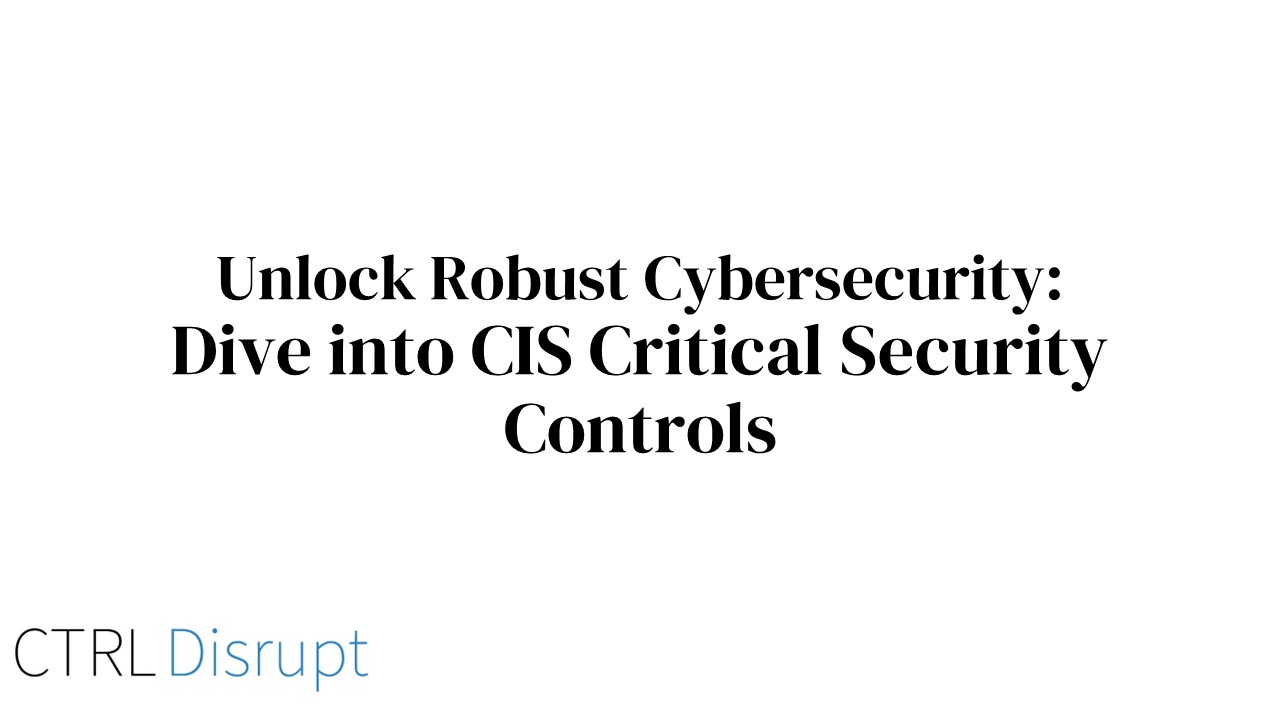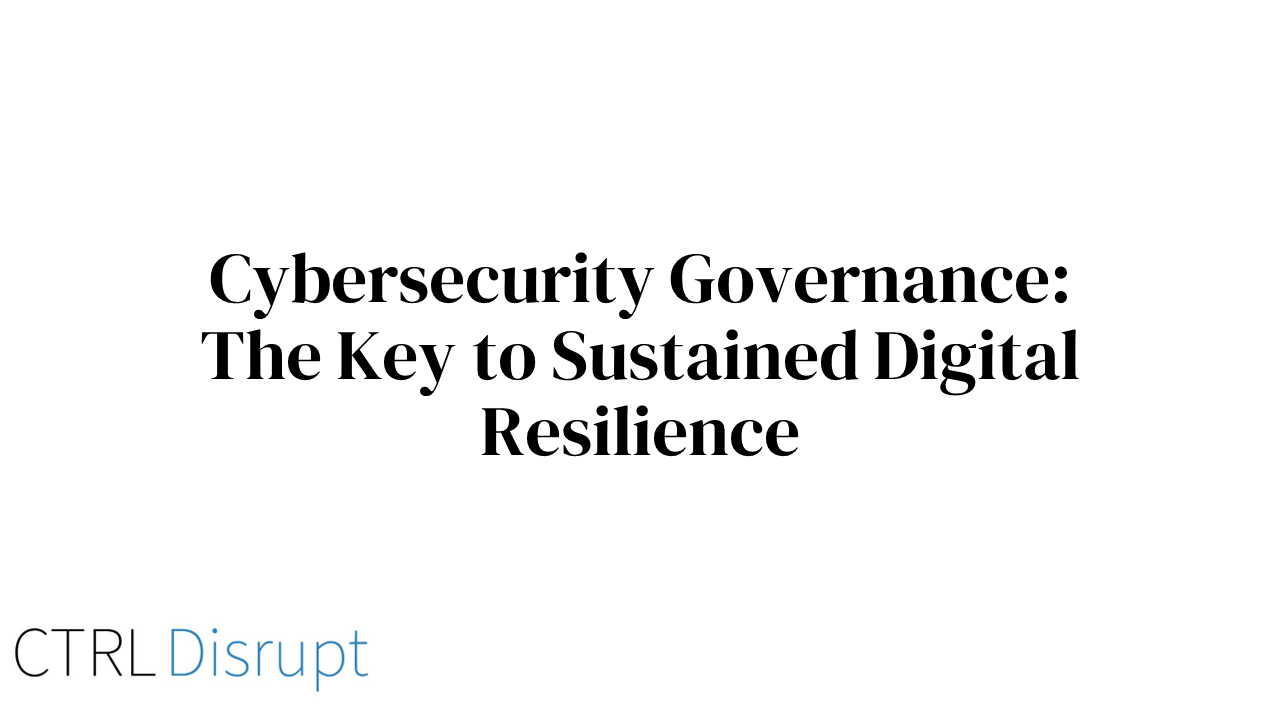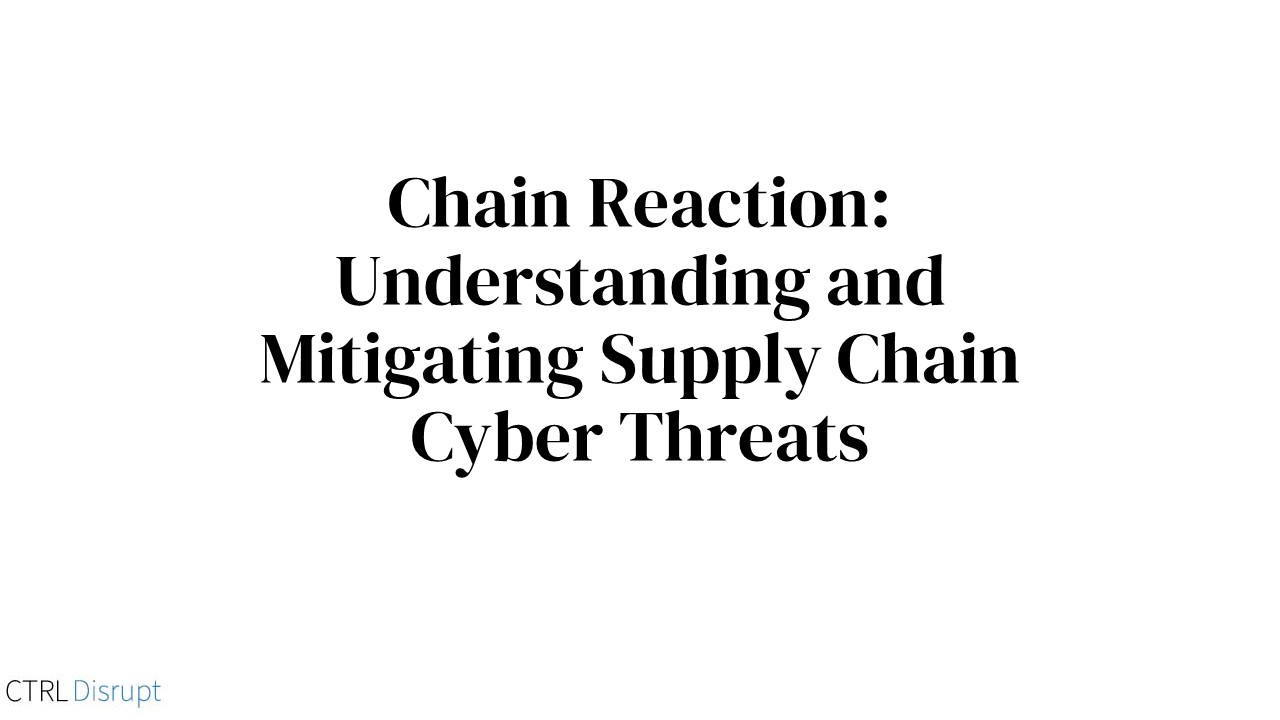From Threats to Triumphs: Mastering Cyber Resilience
1. Introduction
In a time where digital threats are becoming increasingly sophisticated and pervasive, it's imperative for businesses to be not just secure, but resilient. This capacity to both defend against threats and bounce back after adversities is encapsulated in the concept of cyber resilience. Drawing on the NIST Cybersecurity Framework, this article delves into how businesses can master this crucial competency.
2. Understanding Cyber Resilience Through the NIST Framework
Definition and Significance:
Cyber resilience represents an organization's consistent ability to carry out its intended operations despite adverse cyber events. It's a holistic approach to security, emphasizing adaptability and recovery. The NIST Framework, with its five core functions, offers a structured pathway to attain this resilience.
NIST Framework for Cyber Resilience:
-
Identify: Understand the organizational resources and prioritize them based on their risk profiles. This phase is about gaining a clear picture of potential vulnerabilities, threats, and mapping out the cyber risk landscape.
-
Protect: Implement necessary safeguards to ensure the continued delivery of critical infrastructure services. This phase encompasses access control measures, training initiatives, ensuring data security, and putting in place protective technologies.
-
Detect: Constantly monitor the organizational ecosystem to identify cyber events swiftly. This involves the strategic placement of advanced security tools that can instantly pick up on any anomalies or potential breaches.
-
Respond: Upon the identification of a cyber event, this function is about springing into action. It dictates the organization's response, from internal communications, public relations strategies, to the actual technical countermeasures against the threat.
-
Recover: Once the immediate threat has been neutralized, this function focuses on the restoration of any compromised capabilities or services. It emphasizes learning from the incident to bolster future defenses and coordinating recovery efforts effectively.
3. The Rising Tide of Cyber Threats
The last decade has seen a monumental escalation in the volume, variety, and voracity of cyber-attacks. The proliferation of digital platforms, increasing interconnectedness, and the expansion of the Internet of Things (IoT) ecosystem have all presented a wider attack surface for cybercriminals.
A Glance at Notable Cyber-Attacks
From debilitating ransomware attacks like WannaCry and NotPetya to sophisticated cyber espionage campaigns, the fallout from these attacks has reverberated across the globe. Large corporations, critical infrastructures, and even municipalities haven't been immune.
Trends in Cyber Threats:
-
Increasing Sophistication
Gone are the days of unsophisticated phishing attempts. Today's threats often utilize AI, employ multi-layered attack vectors, and demonstrate keen awareness of organizational vulnerabilities. -
Targeted Attacks
Spear phishing, where specific individuals or departments are targeted, is on the rise. These precision attacks can be particularly devastating as they are often harder to detect and prevent. -
Evolving Threat Vectors
As organizations fortify their digital defenses, cybercriminals are diversifying their strategies, targeting everything from cloud platforms to mobile devices.
Examples:
- The SolarWinds Compromise: A stark example of how even trusted software updates can be weaponized, affecting thousands of companies globally.
- The Colonial Pipeline Ransomware Attack: Demonstrating the very tangible repercussions of cyber threats, this attack disrupted fuel supply chains, causing widespread panic and economic ripples
4. The Triumph of Resilience Over Resistance
In the digital realm, as the adage goes, the best defense has often been a good offense. The classic strategy in cybersecurity was, in essence, to build the highest walls and the deepest moats, keeping potential threats at bay. However, the digital landscape is far more dynamic now, with attackers exploiting every conceivable loophole. This calls for a paradigm shift from mere resistance to resilience.
The Limitations of Resistance:
-
Evolving Cyber Threat Landscape
Cyber attackers continually evolve their methods, tools, and strategies. They adapt quickly to conventional defenses, rendering many of the static defenses obsolete over time. -
Human Element
No matter how strong the digital defenses, there's always the human factor. Employees can unknowingly become the weak link, whether it's through spear-phishing attacks, unintentional data leakage, or poor password hygiene. -
Complex Digital Ecosystems
With the rise of cloud computing, IoT, and mobile device usage, organizations are managing broader and more interconnected networks. This complexity can often result in more vulnerability points.
Embracing Resilience:
-
Adaptive Defense Mechanisms
Cyber resilience calls for a strategy that continually adapts. This means leveraging threat intelligence, understanding emerging threat vectors, and routinely reassessing and updating defensive measures. -
Comprehensive Response Strategy
It's not just about rapid recovery but also about having a comprehensive incident response strategy. This should include clear lines of communication, roles and responsibilities during a breach, and predefined procedures to follow. -
Investment in Training
Employees, from top management to front-line workers, need regular training on best practices in cybersecurity. They should be able to recognize threats and know the protocols to follow when they suspect a breach.
A Paradigm Shift in Perspective
The digital battlespace is no longer just about who has the higher walls but about who can bounce back faster and stronger after a fall. It's a shift from a static defensive posture to a dynamic, adaptive one. It's about learning from each incident, iterating on strategies, and cultivating a culture of continuous improvement.
To borrow from the resilient spirit captured by the ancient Japanese proverb, "Fall seven times, stand up eight," it's time organizations internalize that setbacks are inevitable, but surrender isn't. The real measure of an organization's cyber mettle isn't in its ability to prevent every breach but in its capacity to triumph over them through resilience.
5. Strategies for Building Cyber Resilience
In the complex arena of the digital landscape, having a robust defense isn't just about erecting walls; it's also about how quickly we can get back on our feet after a setback.
A Holistic Approach
We must integrate traditional cybersecurity measures with modern resilience strategies. This means combining tried-and-true tools like firewalls and intrusion detection systems with comprehensive incident response plans and recovery protocols.
Continuous Vigilance
The digital realm is always changing, and so are the threats. Advanced systems like Security Information and Event Management (SIEM) offer real-time threat detection. By continuously monitoring and adapting, we can swiftly identify and respond to potential dangers.
Empowering the Human Element
Technology is an essential tool, but our people are the front lines of defense. Regular training sessions can equip them with the skills they need to identify and counter threats. A culture of cyber awareness, where suspicious activities are immediately reported, reinforces the importance of vigilance.
Leveraging Modern Tools
With the rise of machine learning and AI, threat detection has entered a new era. These technologies can sift through vast amounts of data, discern patterns, and even predict potential vulnerabilities. When paired with automated response solutions, the window of exposure to threats diminishes considerably.
The Power of the Cloud
Many modern cloud solutions come with enhanced security features that aid in data backup, disaster recovery, and resource distribution. These ensure a distributed and resilient defense.
6. Benefits of Mastering Cyber Resilience
In today's digital age, where threats seem to lurk at every corner, mastering cyber resilience isn't just a strategic move—it's a survival tactic. Here's how organizations stand to benefit:
Upholding Operational Continuity
One of the most immediate payoffs of cyber resilience is reduced downtime after breaches. By ensuring a system can bounce back quickly from a setback, we minimize disruptions, ensuring that businesses can continue their operations almost seamlessly even after a security event.
Safeguarding Brand Integrity
In a world driven by consumer trust, a single security mishap can tarnish a brand's reputation built over years. Cyber resilience helps in preserving that hard-earned brand reputation. When customers know that a company is robustly shielded against threats and can recover rapidly from any breaches, their trust deepens, solidifying brand loyalty.
Cost Efficiency for the Future
While building resilience might seem like an upfront investment, the long-term financial benefits are tangible. Post-breach remediation, lost business opportunities, and potential legal liabilities can rack up substantial costs. By investing in cyber resilience, organizations can avoid these unforeseen expenses and ensure more predictable financial operations.
Staying Ahead of the Regulatory Curve
The regulatory landscape around cybersecurity is continuously evolving, with many countries and industries imposing stricter standards. A cyber-resilient organization, by its very nature, tends to align with these standards more naturally. This not only reduces the risks of non-compliance penalties but also positions the organization as a responsible and forward-thinking entity in the market.
7. Challenges to Achieving Cyber Resilience
While the merits of cyber resilience are clear, achieving it is no straightforward task. Many organizations struggle to develop and maintain a resilient cybersecurity posture, and a myriad of challenges contribute to this complexity.
The Evolving Threat Landscape
At the forefront is the ever-shifting nature of cyber threats. Just as organizations adapt to one form of threat, adversaries innovate, finding new vulnerabilities to exploit. The challenge is not just to protect against known threats but to anticipate and prepare for future ones. This requires a deep understanding of one's digital infrastructure, proactive threat hunting, and staying abreast of the latest threat intelligence.
Balancing Agility and Security
In today's fast-paced business environment, agility is paramount. Organizations must be able to quickly launch new products, enter new markets, and adapt to changing conditions. But with speed comes risk. Every new application, every piece of hardware, and every partnership introduces potential vulnerabilities. The challenge lies in ensuring that this pursuit of agility does not undermine the security posture.
Skill and Resource Gap
Cyber resilience is not just about having the right tools but also about having the right talent. There's a well-documented shortage of skilled cybersecurity professionals globally. Companies, especially those not inherently tech-focused, find it challenging to attract, retain, and train talent equipped to handle sophisticated threats.
Organizational Silos
In many large corporations, departments operate in silos, each with its own set of objectives and metrics. Such silos can impede the flow of critical security information, leading to disjointed responses in times of crises. Building cyber resilience requires a cohesive, organization-wide approach, wherein every department understands its role in the broader security framework.
Overcoming Complacency
Perhaps one of the most subtle, yet dangerous challenges, is complacency. Organizations that have not experienced significant cyber incidents may develop a false sense of security. This can lead to underinvestment in resilience measures, only to be caught off-guard when a major incident does occur.
Addressing these challenges requires a holistic, forward-thinking approach to cybersecurity, one that respects the intricacies of the modern business landscape while recognizing the grave consequences of cyber threats.
8. The Road Ahead: Future of Cyber Resilience
The journey of cybersecurity has always been punctuated by innovation, be it from the defenders' side or the attackers'. As we gaze into the future, it's evident that cyber resilience will not just be a strategic imperative but an evolving discipline, informed by technological advancements, geopolitical shifts, and lessons from past breaches.
The Quantum Age
The nascent field of quantum computing promises to revolutionize many sectors, and cybersecurity is no exception. While quantum computers might one day have the potential to crack contemporary encryption methods, they also usher in the promise of quantum encryption – a seemingly unbreakable code. How organizations pivot to embrace the possibilities and challenges of the quantum era will shape the resilience landscape.
AI and Automation
Artificial intelligence is already playing a significant role in cybersecurity, enabling rapid threat detection and response. The future might see AI-driven systems that can not only detect but also autonomously respond to threats, thereby reducing the time between breach detection and mitigation. However, the double-edged sword of AI means adversaries too will harness it for more sophisticated attacks.
The Human Element
Despite advancements in technology, the human aspect of cyber resilience will remain central. Future resilience strategies will likely involve a blend of technological solutions and human-centric approaches, emphasizing continuous training, cultivating a culture of security awareness, and fostering cross-departmental collaborations.
Decentralized Systems
The rise of blockchain and decentralized systems offers intriguing possibilities for security. These systems, by design, are resistant to tampering, offering a potential blueprint for future digital infrastructures that prioritize security by architecture rather than add-on solutions.
Geopolitical Considerations
Cyber resilience strategies will increasingly need to account for geopolitical contexts. As nation-states become more active in the cyber domain, either as defenders or aggressors, understanding the broader political landscape will be crucial for anticipating and mitigating threats.
Interconnected Ecosystems
The future will witness even more interconnected devices, from smart homes to entire smart cities. This expansive digital mesh will require new resilience strategies that consider the interdependencies of these systems and the potential cascading effects of breaches.
As the digital frontier expands and evolves, so will the threats that loom over it. However, armed with foresight, innovation, and a commitment to continuous learning, organizations can navigate this landscape with confidence, turning potential threats into triumphs of resilience.
9. Conclusion
In the ever-shifting sands of the digital age, where cyber threats lurk around every corner and evolve with alarming speed, the imperative for organizations is clear: it's not enough to simply defend. As we've journeyed through the intricate landscape of cyber resilience, it becomes evident that this isn't just another buzzword but a pivotal cornerstone for any modern business aiming to thrive in an interconnected world.
The stories of cyber breaches that make headlines are often those where defenses were breached, but what doesn't always capture the limelight are the tales of companies that withstood potential catastrophes thanks to their resilience measures. These are the unsung triumphs that signify the true spirit of the digital age: an era where setbacks are expected, but bouncing back is what defines success.
For organizations, the message is loud and clear. Investing in cyber resilience is not a luxury or an afterthought; it's a necessity. It's about anticipating the unforeseen, preparing for the inevitable, and ensuring that recovery from setbacks is swift and robust. As the lines between the digital and physical worlds continue to blur, and as businesses become ever more reliant on digital infrastructures, the cost of complacency is simply too high.
In closing, to every leader, IT specialist, and stakeholder reading this: the call to action is now. Prioritize cyber resilience. Infuse it into your organization's DNA. Collaborate, innovate, and educate. For in the realm of cyberspace, it's resilience that will guide us from threats to triumphs.

 By
By


